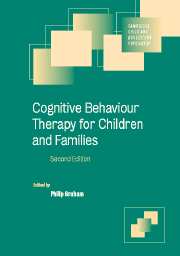Book contents
- Frontmatter
- Contents
- List of contributors
- 1 Introduction
- Part I Developmental cognitive theory and clinical practice
- Part II Engagement and assessment
- Part III Client groups
- Part IV Applications in psychosocial adversity
- Part V Applications in specific child and adolescent psychiatric disorders
- 12 Behavioural approaches to eating and sleeping problems in young children
- 13 Conduct disorders in young children
- 14 Attention deficit hyperactivity disorder
- 15 Children with developmental disabilities and their parents
- 16 Depressive disorders
- 17 Cognitive behavioural psychotherapy for obsessive compulsive disorders
- 18 Anxiety disorders
- 19 School refusal
- 20 Post-traumatic stress disorders
- 21 Disorders of eating control
- 22 Chronic fatigue syndrome
- 23 Children's interpersonal problems
- 24 Pain in childhood
- 25 Conduct disorders in adolescence
- 26 Drug and alcohol abuse
- Part VI CBT applications in preventive interventions
- Index
- References
18 - Anxiety disorders
Published online by Cambridge University Press: 21 August 2009
- Frontmatter
- Contents
- List of contributors
- 1 Introduction
- Part I Developmental cognitive theory and clinical practice
- Part II Engagement and assessment
- Part III Client groups
- Part IV Applications in psychosocial adversity
- Part V Applications in specific child and adolescent psychiatric disorders
- 12 Behavioural approaches to eating and sleeping problems in young children
- 13 Conduct disorders in young children
- 14 Attention deficit hyperactivity disorder
- 15 Children with developmental disabilities and their parents
- 16 Depressive disorders
- 17 Cognitive behavioural psychotherapy for obsessive compulsive disorders
- 18 Anxiety disorders
- 19 School refusal
- 20 Post-traumatic stress disorders
- 21 Disorders of eating control
- 22 Chronic fatigue syndrome
- 23 Children's interpersonal problems
- 24 Pain in childhood
- 25 Conduct disorders in adolescence
- 26 Drug and alcohol abuse
- Part VI CBT applications in preventive interventions
- Index
- References
Summary
Anxiety is a normal human reaction, but becomes a problem when it begins to interfere with a child's education, family and peer relationships, self-esteem, general happiness or ability to participate in everyday activities. Factors that need to be considered when deciding whether or not a child's fear is ‘abnormal’ include the degree of distress experienced and the age-appropriateness of the fear. There is no set-point at which anxiety goes from being ‘normal’ to ‘maladaptive’. Rather, anxiety is best conceptualized as a continuum, with anxiety disorders towards the severe end (Schniering et al., 2000). The need for intervention in children who are impaired by their level of anxiety is highlighted by research showing that children and adolescents who do not receive treatment have a significantly poorer prognosis than those who obtain help (Dadds et al., 1997).
Diagnosis
The fourth edition of the Diagnostic and Statistical Manual of Mental Disorders (DSM-IV; American Psychiatric Association, 1994) includes the following categories of anxiety disorders that can be found in children: separation anxiety disorder (SAD), panic disorder–agoraphobia, obsessive compulsive disorder (OCD), post-traumatic stress disorder (PTSD), acute stress disorder, specific phobia, social phobia and generalized anxiety disorder (GAD). While there is no category specifically for childhood anxiety disorders, DSM-IV does take into account differences in the manifestation of anxiety in children due to cognitive and developmental differences. For example, criteria note that, unlike adults, children and adolescents may not necessarily recognize their fears or anxious behaviours as excessive or unreasonable.
- Type
- Chapter
- Information
- Cognitive Behaviour Therapy for Children and Families , pp. 300 - 319Publisher: Cambridge University PressPrint publication year: 2004
References
- 1
- Cited by



